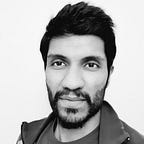A surge of healthcare workers can be bad news for COVID19 pandemic
This is the second of the two posts on this topic. I would recommend reading the first post before going forward. Previously, we discussed an approach to include the healthcare system in the basic Susceptible, Infected and Recovered (SIR) model thereby creating a new model that we called ‘SIRH’. In this research-oriented article, we explore the behaviour of the SIRH model — a quite unintuitive behaviour to be precise.
This post is a summary of more detailed information and analysis that can be found here. Interested readers are encouraged to look at the Jupyter notebook in the link above.
The SIRH model considers a twofold role played by healthcare professionals (H) in disease control — one as recovery agents and another as highly susceptible individual with incomplete PPE.
The governing equations of this simple model are as follows:
𝑣0=𝑘[0]∗𝑆∗𝐼
𝑣1=𝑘[1]∗𝐼
𝑣2=(1−𝑘[2])∗𝐻∗𝐼
𝑣3=(𝑘[3]∗𝑘[4])∗𝐻∗𝐼
k[0] : population contact rate
k[1] : natural recovery rate (natural infectious period)
k[2] : PPE fraction available
(1-k[2]) : contact rate of healthcare workers with patients
k[3] : recovery rate with treatment (infectious period with treatment)
k[4] : ventilator/other equipment fraction available
The corresponding differential equations are:
𝑆 ’=−𝑣0
𝐼 ′=𝑣0+𝑣2−𝑣1−𝑣3
𝑅 ′=𝑣1+𝑣3
𝐻 ′=−𝑣2
𝑁=𝑆+𝐼+𝑅+𝐻
𝑆 ′+𝐼 ′+𝑅 ′+𝐻 ′=0
With ‘H’ at the critical junction of either helping out patients or becoming patients themselves, an interesting question to ask is how would the dynamics of ‘H’ affect that of ‘I’ considering insufficient availability of PPE and medical equipment.
The general strategy to deal with skyrocketing infections in the coronavirus pandemic seems to be to gather all the healthcare support that is available and provide basic treatment as cases flow in. More healthcare support is always a good thing working towards patient recovery. Or is it?
Healthcare workers can increase patient load!
The SIRH model predicts that there can be times when more healthcare workers result in higher number of infected cases than fewer healthcare workers can. In this counter-productive system, more healthcare workers can proportionately result in more infected cases and the infection peak reaches quicker. This effect arises because ‘H’ are more vulnerable to infections (lack of PPE) than they can treat patients (lack of ventilators). This means more ‘H’ become infected than more ‘I’ recover. In other words, bringing in more ‘H’ on board will only make things worse.
How can equations explain this?
𝐼 ′=𝑣0+𝑣2−𝑣1−𝑣3
𝐼 ′=(𝑘[0]∗𝑆∗𝐼)+((1−𝑘[2])∗𝐻∗𝐼)−(𝑘[1]∗𝐼)−(𝑘[3]∗𝑘[4]∗𝐻∗𝐼)
𝐼 ′=𝐼(𝑘[0]∗𝑆−𝑘[1]+(1−𝑘[2]−𝑘[3]∗𝑘[4])∗𝐻)
𝐼 ′∝(1−𝑘[2]−𝑘[3]∗𝑘[4])
𝐼 ′∝(1−𝑃𝑃𝐸−𝑅𝑒𝑐𝑜𝑣𝑒𝑟𝑦𝑅𝑎𝑡𝑒𝑡𝑟𝑒𝑎𝑡𝑚𝑒𝑛𝑡∗𝑉𝑒𝑛𝑡𝑖𝑙𝑎𝑡𝑜𝑟𝑠)
1. Criteria for a productive outcome (fewer infected cases with more healthcare workers)
𝑃𝑃𝐸+𝑅𝑒𝑐𝑜𝑣𝑒𝑟𝑦𝑅𝑎𝑡𝑒𝑡𝑟𝑒𝑎𝑡𝑚𝑒𝑛𝑡∗𝑉𝑒𝑛𝑡𝑖𝑙𝑎𝑡𝑜𝑟𝑠>1 ; meaning PPE and medical equipments (ventilators) should be adequately available assuming constant treatment-based recovery rate
2. Criteria for a counter-productive outcome (more infected cases with more healthcare workers)
𝑃𝑃𝐸+𝑅𝑒𝑐𝑜𝑣𝑒𝑟𝑦𝑅𝑎𝑡𝑒𝑡𝑟𝑒𝑎𝑡𝑚𝑒𝑛𝑡∗𝑉𝑒𝑛𝑡𝑖𝑙𝑎𝑡𝑜𝑟𝑠<1 ; meaning there will be a deficit of PPE and medical equipments (ventilators) assuming constant treatment-based recovery rate
Factors regulating this counter-productive system
For the arbitrary parameter values used in the SIRH model, we find that a certain minimum threshold of PPE and ventilators should be available to avoid a counter-productive system. Excess supply of ventilators with sub-minimal availability of PPE can still result in counter-productive results.
Lack of medical equipment generates a proportionally growing patient load. Simulations show that the maximum number of patients steadily increase with more healthcare workers armed with insufficient medical equipment (PPE and ventilators) conditions and the converse. Furthermore, the peak time for the infection is also earlier under these conditions.
Summary
The statistician George Box said — All models are wrong but some are useful.
I hope the SIRH model can shed some light on the role of healthcare system in the coronavirus pandemic. We simulated the model with hypothetical parameter values but these values are not absurdly unrealistic. Poor management of a disease outbreak could push the system into a counter-productive space where well-intended measures can result in drastic outcomes. Until we have a cure for COVID19, a strong workforce of healthcare professionals armed with adequate medical equipment along with sensible physical distancing measures are the way to fight the current pandemic.
